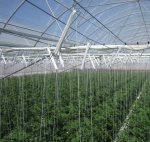Australia is home to a food production revolution – Sundrop Farms near Port Augusta is successfully growing high-value crops using seawater and sunlight in what would be considered extremely hostile conditions for horticulture.
With energy and water costs responsible for up to 70% of total farm expenses in some regions and irrigation accounting for 70 percent of the 3,240 cubic kilometres of water withdrawn for human use, Sundrop Farms’ progress is being keenly monitored.
The Sundrop Farms System uses solar power to desalinate seawater to produce freshwater for irrigation and to generate electricity to power its climate-controlled greenhouse.
The seawater based greenhouse ventilation also cleans and sterilises the air, making it possible to grow crops without chemical pesticides.
The Sundrop Farms System allows land normally not deemed suitable for agriculture or horticulture to produce large quantities of food. The company claims its hydroponics based greenhouse growing methods yield 15-30 times more produce per hectare than conventional field production. Each hectare of Sundrop Farms greenhouses also directly employs between 5-7 people
Even the salt by-product of desalination has value – it’s mostly sold to third parties and some of the minerals are at times re-used in Sundrop Farms’ greenhouse as plant nutrients.
In addition to horticultural applications, the system can also be used for floriculture and aquaculture.
With modern food systems sometimes resulting in production occurring thousands of kilometres away from the point of consumption, Sundrop Farms type systems can also play a role in substantially reducing food miles; which can significantly add to the carbon footprint of food.
A planned 8 hectare expansion of the Port Augusta facility aims to produce 2.8 million kg of tomatoes and 1.2 million kg of peppers annually while saving the equivalent of approximately 4.6 million barrels of oil equivalent and 280 million litres of fresh water per year compared to a standard greenhouse in a similar location.














































